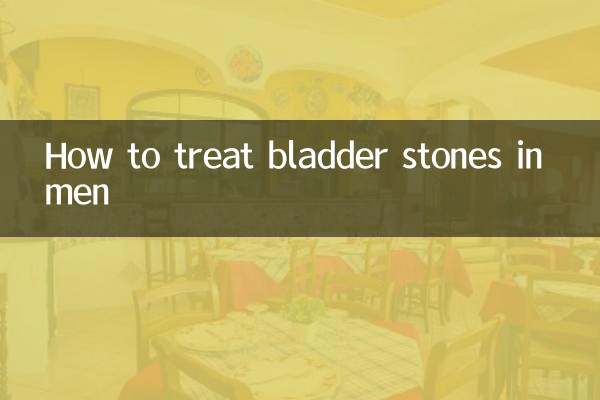How to treat bladder stones in men
Bladder stones are one of the common diseases of the urinary system. The incidence rate is higher in men than in women, especially in middle-aged and elderly people. Among the hot topics on the Internet in the past 10 days, the treatment and prevention of bladder stones have been highly discussed. This article will combine the latest medical information to provide structured data and analysis for male patients to help understand the treatment of bladder stones.
1. Causes and symptoms of bladder stones

The formation of bladder stones is mostly related to urine retention, infection or metabolic abnormalities. Common symptoms include:
| Symptom type | Specific performance | Incidence (male patients) |
|---|---|---|
| Abnormal urination | Frequent urination, urgency, and painful urination | 85% |
| hematuria | Gross or microscopic hematuria | 60% |
| pain | Dull pain in the lower abdomen or perineum | 75% |
2. Diagnostic methods of bladder stones
The diagnosis of bladder stones requires a combination of clinical manifestations and auxiliary examinations:
| Check items | Advantages | limitation |
|---|---|---|
| Ultrasound examination | Non-invasive and economical | Less sensitive to small stones |
| X-ray examination | Can show positive stones | Unable to display negative stones |
| CT examination | High accuracy | Large amount of radiation |
3. Treatment options for male bladder stones
Treatment plans need to be formulated based on stone size, composition and individual patient conditions:
| Treatment | Indications | success rate |
|---|---|---|
| Medication to remove stones | Stone diameter <0.5cm | 60-70% |
| extracorporeal shock wave lithotripsy | 0.5-2cm stones | 80-90% |
| transurethral cystoscopic lithotripsy | >2cm or complex stones | More than 95% |
4. Latest Treatment Technology Progress
According to medical journal reports in the past 10 days, there are the following new developments in the field of bladder stone treatment:
1. Laser lithotripsy technology: The efficiency of holmium laser lithotripsy is increased by 30%, and the operation time is shortened.
2. Mini endoscope: less invasive and suitable for elderly patients.
3. Artificial intelligence assistance: Preoperative CT three-dimensional reconstruction can accurately formulate surgical plans.
5. Measures to prevent bladder stones
Preventing recurrence is an important part of treatment:
| Precautions | Specific methods | Effect |
|---|---|---|
| Drinking water management | 2000-3000ml daily | Reduce recurrence rate by 40% |
| diet modification | Low salt and low protein diet | Reduce recurrence rate by 35% |
| Regular review | Ultrasound every 3-6 months | Early detection rate 90% |
6. Answers to Frequently Asked Questions by Patients
Q: How long does it take to stay in the hospital for bladder stone surgery?
A: Generally, minimally invasive surgery requires a hospitalization of 3-5 days.
Q: How much does treatment cost approximately?
A: Depending on the surgical method, the cost ranges from 5,000 to 20,000 yuan.
Q: How long does it take to return to work after treatment?
A: Office work can usually be resumed after 1 week, and physical work is recommended to take 2-3 weeks of rest.
Conclusion:
The treatment of male bladder stones requires an individualized plan. It is recommended that patients seek medical treatment promptly and have the most suitable treatment method selected after evaluation by a professional urologist. At the same time, establishing good living habits is the key to preventing recurrence. The application of the latest medical technology makes bladder stone treatment more precise and safer.

check the details

check the details